Papers by Giedrius Subačius

Senoji Lietuvos literatūra, 55, p. 137–155, 2023
There are two known stone monuments with epitaphs, written by Simonas Daukantas in his own orthog... more There are two known stone monuments with epitaphs, written by Simonas Daukantas in his own orthography: for a relative priest Simonas Lopacinskis (died in 1814) and for his mother Kotrynė Daukantienė (died in 1847). Analysis of Lopacinskis’s epitaph spelling proves that Daukantas inscribed the text of the gravestone approximately in 1838–1841 (24–27 years after the death of Lopacinskis). His mother’s epitaph is said to be compiled by Daukantas in the beginning of 1848. And graphochronological research reconfirms that this epitaph includes features characteristic to Daukantas orthography in about 1848–1850
Entire Lopacinskis’s epitaph was chiseled out in capital letters. Analysis shows, however, that most of the text written by Daukantas hand must have initially been rendered in lower case letters. And Daukantienė’s epitaph might have been chiseled out not directly from Daukantas’s handwritten note, but from the text first set in print.
Daukantas spelled his mother’s last name DAU‑KONTIENE with the digraph <on>, signifying her native dialectal diphthong [ọn]. Elsewhere at the time Daukantas preferred different digraph <ąn>, so the spelling with <on> might have been an important identity trait of his mother and of his entire family. Had Daukantas’s own signature in Lithuanian survived, it might have contained the same digraph <on> – Daukont’s or Daukontas.
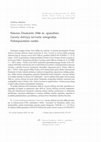
Archivum Lithuanicum, 2023
In 1846, Simonas Daukantas (1793–1864) published his translation of Cornelius Nepos’ Lives of Emi... more In 1846, Simonas Daukantas (1793–1864) published his translation of Cornelius Nepos’ Lives of Eminent Commanders (in Lithuanian Giwatas Didiujû Karwaidû, GDKs) at Christian Hintze’s printing press in St Petersburg. This study analyses the orthography in GDKs. There was a previous translation of the book by Daukantas in around 1834 (about 12 years earlier), and most of it survives in the shape of a copy by an anonymous hand. The book was printed from a later manuscript that did not survive.
It is obvious that Daukantas had the earlier translation in front of him while preparing the publication. But even if he copied some features of his old orthography, he also often changed the orthography according to his later altered preferences.
Another book by Daukantas published the same year (1846) was Pasakas Phedro (PaPhs), a translation of The Fables of Phaedrus. The manuscript of PaPhs was prepared in Daukantas’ own quite renewed orthography (compared to his older manuscript of the same fables Pasakas Paedraus from the first half of 1836).
The first quarter of the GDKs text was prepared in similar way to PaPhs: Daukantas preferred to replace old orthographic features with newer ones. However, the other three quarters of the GDKs book were prepared differently: many more older orthographic peculiarities were introduced, such as: <‑iba, ‑ibe> (not <‑yba, ‑ybe>); <‑ay, ‑ey>, <‑ai, ‑ei> (not <‑aj, ‑ej>); <‑ij, ‑ei> in open [‑ẹi] flexions (not <‑ĩj>); <ei>, <ęi>, <ij> in word roots (not <ĩj>); inf. suffix <‑itĩ> (not <‑ytĩ>). The most plausible reason for the decline in Daukantas’ interest in renewing the older orthography in his new manuscript (beginning in the second quarter) was his sudden illness. Daukantas claimed that at the beginning of January 1846, the blood was rushing inside his head so much that he thought he was going mad or dying, and only after four months did the doctors manage to help him recover enough so that he was able to walk. Nevertheless, the pain in his legs was still terrible, and he could not walk further than a few hundred paces at a time. And approximately at that time, Daukantas was working on his GDK manuscript, so it is possible that the misfortune befell him when he was a quarter of the way through his work. It also means that, even though sick and in pain, he continued writing.
Not all the orthographic features were of the same stability. Some of them were quite stable, and Daukantas adapted new versions of expressions even while he was ill (yra; <‑ajs, ‑ejs>; <ąn ąm>; <‑tĩ>; buwo). Other features were less stable and even very unstable, affected by the obvious influence of the orthography of the former manuscript. Among the least stable was the discarding of the grapheme <y> in the position of a long vowel [i·, i]: derivatives with the inf. suffix <‑it‑>; the root giw‑ (‘life, alive’), etc. Also, the diacritical grapheme <ù> was not stable either in PaPhr or in GDKs.
These old graphemes that penetrate new texts might be termed palimpsestic. Old graphemes in new texts, especially those that are characterised by less stability, are palimpsestic. This feature was present to some degree in other writings by Daukantas as well: in some manuscripts we can unexpectedly find the grapheme <y> with the very old meaning of the Lowland Lithuanian sound [ẹ] (pronounced somewhat between [i] and [e]), such as the History of the Lithuanian Lowlands of 1831–1834; proverbs copied from Kristijonas Gotlybas Milkus’ dictionaries and Lowland Lithuanian proverbs, both from about 1838, etc. Also, beside the newer grapheme <ó> [ọ], we can find the older <ù> [ọ] in Lowland Lithuanian proverbs, which is a sign that the text was copied from an older manuscript and acquired the former palimpsestic <ù>.
Oikos, 2023
Kalbos istorikas, sociolingvistas, Simono Daukanto veikalų tyrinėtojas profesorius Giedrius Subač... more Kalbos istorikas, sociolingvistas, Simono Daukanto veikalų tyrinėtojas profesorius Giedrius Subačius jau beveik 30 metų gyvena Jungtinėse Amerikos Valstijose, kuriose Čikagos Ilinojaus universitete užsienio studentus supažindina su Lietuvos istorija ir lietuvių kultūra. Jis gerai pažįstamas ir Lietuvos filologų bendruomenei, atpažįstamas ir iš jau trečią dešimtmetį skaičiuojančio žurnalo "Archivum Lithuanicum". Lietuvos kolegos noriai užsuka į svečius Čikagoje. Dalijamės keliais Lituanistikos katedroje viešėjusios dr. Viktorijos Jonkutės pokalbio su profesoriumi fragmentais. Kalbėtasi apie dėstytojo darbą, studentus, profesijos pasirinkimą ir, žinoma, kalbą.

Akadēmiskā Dzīve 59/2023/2024, 2023
The Lithuanian word valstybė ‘state, polity’ was first registered in 1831–1833 in a Lithuanian te... more The Lithuanian word valstybė ‘state, polity’ was first registered in 1831–1833 in a Lithuanian text by Simonas Daukantas – History of the Lithuanian Lowlands (Istoryje Zemaytyszka) in Riga, Latvia.
Daukantas borrowed the word valstybė from Latvian. He believed he had appropriated the word from the Herulian language (not Latvian) via Joachim Lelewel’s text. The word had reached Daukantas Lelewel (1808) → Daukantas (1831–1833).
Daukantas’ work at the General Governor’s office in Rīga must have stimulated him to transfer valstybė into Lithuanian. Daukantas must have seen the printed texts containing the Latvian combination Kreewu(=) walſtibas ‘of the Russian state’ that were circulating in the office, which could have encouraged him to adapt it for his Lithuanian text.
One of the first to resurrect Daukantas’ forgotten loanword valstybė was the writer, political activist Povilas Višinskis, in the January 29 [February 11], 1905 issue of the Lithuanian newspaper Vilniaus žinios (‘Vilnius News’) in the article “Kiek pinigų surenka ir išleidžia Rusų vyriausybė” (How Much Money the Russian Government Collects and Spends). Possibly, during the beginning and certainly by the middle of 1905 Višinskis fully switched to using the word valstybė and abandoned viešpatystė and valstija, which were popular synonyms at the time. After Višinskis, a member of the Lithuanian Social Democratic Party, Augustinas Janulaitis, used the word valstybė in March and April, 1905. At the very end of 1905 the linguist Jonas Jablonskis must have accepted the fact that valstybė had become the more widely used word.
The Russian revolution and the war with Japan in 1905, the Great Assembly of Vilnius at the end of 1905, and the State Parliament elections at the beginning of 1906 made the concept of ‘state, polity’ very frequent and relevant. In 1906, valstybė finally won the competition with its synonyms as the most correct way of expressing the concept. It was noteworthy that Višinskis (circa January 1905) and Janulaitis (circa April 1905) had selected this word, but the approval by Jablonskis (circa December 1905) could have been the most decisive factor for the subsequent wide spread of the word valstybė.

The Cambridge Handbook of Historical Orthography, eds. Marco Condorelli, Hanna Rutkowska, 2023
Historically, orthography has always been dependent on the materiality
(physicality) of writing ... more Historically, orthography has always been dependent on the materiality
(physicality) of writing tools and surfaces. In the development of orthographies,
the perception of durability and ephemerality has been a significant factor
as well: in certain cases, hopes for permanence as opposed to temporality
encouraged orthographic differences in written (printed) texts. In ancient
Rome, for example, capital letters carved in stone were more durable than the
minuscules used on wax tablets. After the invention of movable type printing
in fifteenth-century Europe, manuscripts became more ephemeral than
printed texts. For instance, newspapers printed in Lithuania at the end of the
nineteenth century were considered more perishable than printed books.
The materiality of the printing milieu was one of the main reasons for the
symmetry of the majuscules and minuscules in orthographies based on Latin
script and for the absence of most of the abbreviations that are characteristic
of medieval manuscripts. Constrained by the space available within printers’
type cases, the number of typefaces would have been limited, which may
have impacted the development of certain orthographies and may have constrained
the abundance of diacritic marks. The direct materiality of a sheet of
paper also may have influenced the presence of hyphens and abbreviations,
and in certain cases, the choice of graphemes.
This chapter focuses on the materiality of orthography as approached from
the perspective of such research fields as paleography, codicology and orthography.
Materiality as a physical condition or reason for spelling transformations
and variation is considered as either restrictive or encouraging physical
reality for an applied orthography. The chapter then discusses the way the
imaginary durability or ephemerality of the composed text might influence
the orthographic approach (minuscules vs. majuscules, double parallel...
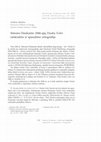
Archivum Lithuanicum 24, 2022
Simonas Daukantas prepared two manuscripts of his Lithuanian translation of the Fables of Phaedru... more Simonas Daukantas prepared two manuscripts of his Lithuanian translation of the Fables of Phaedrus: one in the first half of 1836 (PaP), and another ten years later in about the first half of 1846 (PaPhr). Daukantas exploited two different orthographic tactics in tapping the first manuscript (PaP) as the source for the second one (PaPhr): (1) either to substitute older orthographic peculiarities for his own more recently introduced spelling equivalents
(more frequent approach), or (2) just to keep them (more seldom).
(1) Habitually, Daukantas modified the features of the earlier PaP manuscript: (a) <i, î> [ẹ] → <ĩ> (Ƶînau ‘I know’ → Źĩnau); (b) [i·, i] in stems <i> → <y> (būti ‘to be’ present 3‑person form [ira ‘it is’ → yra], suffixes ‑yba, ‑ybė [prekibà ‘to the trade’ → prekybaj, narsibieje ‘in valor’ → narsybie], inf. suffix <i> → <y> [mokite ‘to teach’ → môkytĩ]); (c) in stems and endings <ai, ei> (<ae>, <iey>) → <aj, ej> (Ƶaemaite ‘Lowlanders’ → Ƶámajtej; w eislę ‘a breed’ → wejslę); (d) [ẹi] in open endings <ij> → <ĩj> (kurij ‘which ones’ → kùrĩj); (e) [ẹi] in roots <ei> → <ie> (deina ‘a day’→ dieną) and <ei> → <ĩj> (lijpę ‘[he] ordered’ → lĩjpę); (f) instr. pl. m. endings <‑ays, ‑eys>, <‑às, ‑ès> → <‑ajs, ‑ejs> (łondeys ragays ‘[with] the
pointed horns’ → łąndejs ragajs; aukuràs ‘[with] the altars’ → aukùrajs); (g) <on, om, an> (<un>) [ọn, an, ọm, am] → <ąn, ąm> (spindontiomys ‘[with] the glittering [something]’ → spindąntiomis; gełombiemys ‘[with] the baize’ → gełąmbiemis); (h) inf. ending <‑te> → <‑tĩ> (důte ‘to give’ → důtĩ); (i) būti ‘to be’ past 3‑person form bů ‘was’ → buwo; (j) dat. sg. m. and adv. Lowlanders’ endings <‑ů> [ọu] → Highlanders’ endings <‑uj> [‑ui] (skaititoiů ‘to a reader’ → skajtitojuj, pasků ‘later; afterwards’ → paskuj).
(2) More occasionally he was influenced by the equivalent in the prototype PaP and kept it: (a) [i·, i] in stems <i> = <i> (in forms deriving from inf. suffix [pawiks ‘(I) will succeed’ = pawiks]), in the root gyv‑ (negiwije ‘dead ones’ ≈ negiwĩje), in other roots (ligino ‘[he] leveled’ = ligino; tiłù ‘silently’ = tiłù); (b) grapheme <ù> [ọ] (miniesinù ‘[with] the mentioning’ = miniesinù).
Daukantas abundantly exploited one feature in both old and new orthographic versions: graphemes <ů> / <ou> (ůdegą ‘a tail’ = ůdegą; pardůs ‘will sell’ → pardous). He essentially returned to his older grapheme <ů> (168×), although equally important remained the digraph <ou> (205×). In the initial (pp. 3–9) and final (pp. 52–63) segments of the PaPhr manuscript, Daukantas chose only the digraph <ou>, but within the inner (pp. 3–11, 26–51) segments his tactic was different: he blended <ů> with <ou>. Another tendency: frequent
pronominal acc. sg. forms ką, tą and instr. sg. kuo, tuo (including variations) were mostly rendered as kou, tou, most probably due to the old knack of his hand.
In certain cases, Daukantas modified not only orthography, but dialect forms as well, i.e. he chose different diatopic variants. Instead of the former Lowland forms, he switched to these Highland equivalents: (a) digraph <ie> [ie] in the roots dien‑ ‘day’, Diev‑ ‘God’, vien‑ ‘one’, viet‑ ‘place’; (b) dat. sg. m. and adv. endings <‑uj> [ui]; (c) past 3-person form buwo ‘was, were’.
The printer of the book (PaPhs) was Eduard Pratz in St Petersburg. His typesetters worked better than the typesetters at the printing press of Christian Hintze that Daukantas used for his earlier publications. In Hintze’s editions there were many mistakes in both letters and their diacritical marks. In PaPhs, however, there were fewer cases of grapheme confusion. It is highly probable that at least one of the PaPhs typesetters knew Lithuanian (especially the setter of the fourth and fifth signatures on pp. 37–48, 49–60), and that at least one was ignorant of it (the setter of the third signature, especially pp. 29–36).
It is thinkable that Daukantas could have familiarised himself with the typeset text before some of the proofs were corrected (the word Leaukys ‘wolf’, typical only of Daukantas, was introduced in print even though the manuscript lacks it). The majority of the corrections, however, were probably established by the typesetters, especially by the one who knew Lithuanian and introduced some forms atypical of Daukantas himself (such as tautosyllabic digraph <ĩn> [ẹn]—teatsitink ‘let it happen’ → teatsĩtĩnk). The financial supporter of the publication, Ksaveras Kanapackis, might have been a speaker of the Eastern Highland dialect; thus, he was not in a position to insert such Lowland dialect features as iness. sg. f. (pastogie ‘in the shelter’) and diacritical letters <ĩ> [ẹ] and <ù> [ọ].
Archivum Lithuanicum, 2021
Lietuvos istorijos institutas, 2021
This monograph “Simonas Daukantas’s Saint Petersburg Orthography (1834–1846)” continues research ... more This monograph “Simonas Daukantas’s Saint Petersburg Orthography (1834–1846)” continues research on the history of Lithuanian orthography begun in my monograph, “Simonas Daukantas’s Rīga Orthography (1827–1834).” It covers Daukantas’s subsequent orthographic efforts while living in Saint Petersburg, Russia, during the period of 1835–1845. Based on an analysis of orthography and extra-linguistic factors, I have reconstructed a plausible chronology of Daukantas’s Saint Petersburg texts up to 1846.
Draugas, 2022
2022 m. balandžio 7 d. susitikti su PLB Lituanistikos katedros Ilinojaus universitete Čikagoje s... more 2022 m. balandžio 7 d. susitikti su PLB Lituanistikos katedros Ilinojaus universitete Čikagoje studentais atvyko kanadietis autorius Gordon Mott, neseniai išleidęs romaną "Lithuanian Lullaby" ("Lietuviška lopšinė"). Lietuvių kultūros kurso klausytojams Gordon papasakojo, kaip pirmą kartą pateko į Lietuvą. Pirmiausia jis susipažino su į Kanadą atvykusiu studentu Dariumi Žeruoliu, o šis jau prikalbėjo Gordon atvykti į Lietuvą ir vienerius metus mokyti 8 ir 10 klasių mokinius anglų kalbos vienoje Klaipėdos mokykloje. Tai buvo apie 1990 metus.
Upton Sinclair „Džiunglės“; Aukso žyuvys, 2022
Uptonas Sinclairis (1878–1968) romaną „Džiunglės“ parašė 1905 m. ir atskira knyga išleido 1906-ai... more Uptonas Sinclairis (1878–1968) romaną „Džiunglės“ parašė 1905 m. ir atskira knyga išleido 1906-aisiais. Ją perskaitęs tuometinis Jungtinių Amerikos Valstijų prezidentas Teodore’as Rooseveltas į Baltuosius rūmus pasikvietė 28-erių metų autorių ir per pietus su juo svarstė mėsos pramonės problemas1. 1975 m. U. Sinclairio biografas Leonas Harrisas jį pavadino reikšmingiausiu rašytoju Jungtinių Valstijų istorijoje2 – jo „Džiunglių“ paveiktas Kongresas dar tais pačiais 1906 m. priėmė naują federalinį Švaraus maisto ir vaistų įstatymą – dėl šio romano amerikiečių stalus ėmė pasiekti higieniškesnė mėsa.
Archivum Lithuanicum, 2021
Anksčiausia, ką prisimenu, tai Williamo R. Schmalstiego kaliošai, arba purvabridžiai, kaip tais l... more Anksčiausia, ką prisimenu, tai Williamo R. Schmalstiego kaliošai, arba purvabridžiai, kaip tais laikais mėginta sakyti. Vilniaus universitete tada buvau aspirantas (dabar būčiau doktorantas), Schmalstiegas 1986 m. buvo atvykęs į Vilnių su savo dukra rudens semestrui rinkti medžiagos savo angliškai rašysimai Lietuvių kalbos istorinei sintaksei. Daug lijo, ir Schmalstiegas ant batų dar apsiaudavo kaliošus, tikrus kaliošus, tokius, kokius atsimenu vaikystėje matęs Maksimonių kaime įsispiriant, kai bobutė eidavo žalosios milžt. Vilniuje tada kaliošai jau nebebuvo atpažįstami kaip realiai funkcionuojantis apavas, gal tik kaip koks istorizmas ar kaimą nostalgizuojančios literatūros ornamentas. Kai atėję į Baltų filologijos katedrą matydavom kertelėje suglaustus kaliošus, žinojom, kad Schmalstiegas jau universitete – gal bibliotekoj, gal paskaitoj.
Bridges, 2022
Some parts of the Lithuanian language, some aspects, are very old. But not the whole language as ... more Some parts of the Lithuanian language, some aspects, are very old. But not the whole language as such. After all, if the whole language was old, it would be dead. But we have new words for things that simply did not exist in the past.
LA VIE DE L’ESPRIT EN EUROPE CENTRALE ET ORIENTALE DEPUIS 1945. Dictionnaire encyclopédique, 2021
Marija Birutė Gimbutas (Gimbutienė), archéologue et mythologue américaine d’origine lituanienne. ... more Marija Birutė Gimbutas (Gimbutienė), archéologue et mythologue américaine d’origine lituanienne. Titulaire de doctorats honoris causa de l’université de Californie (1975) et de l’université de Vilnius (1993). Née à Vilnius, en Lituanie, elle fait son éducation universitaire en Lituanie et en Allemagne.
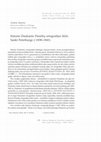
Archivum Lithuanicum 22, 2020
Simonas Daukantas (1793–1864) moved to St Petersburg in 1835. Impermanence and competition of var... more Simonas Daukantas (1793–1864) moved to St Petersburg in 1835. Impermanence and competition of variants were typical for his orthography. During the four initial years in that city, Daukantas managed to shape at least two consecutive distinct Lithuanian orthographies of his own: (1) of the Beginning Years in St Petersburg (1835–1836) and (2) of his First Printed Books (ca. the 2nd half of 1836 to 1838). This study analyzes Daukantas’s third period of significant orthographic transformations during his residency in St Petersburg—a prolonged four-year phase of orthographic modifications that can be termed the Orthographic Switch of Proverbs (ca. 1838–1841), since the change was best reflected in the draft lists of proverbs. The major orthographic data was collected from Daukantas’s manuscript Margumynai (‘Miscellanea’, p. 156–166, LLTIBR: f. 1 – SD 27) and printed book Abecieła Lîjtuwiû-Kalnienû ir Żiamajtiû Kałbos (‘The Primer of the Lithuanian Language—of Highlanders and of Lowlanders’, St Petersburg, 1842).
Lietuvos istorijos institutas, 2018
Summary of a monograph
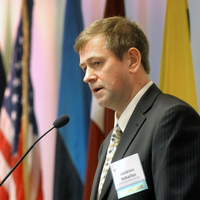


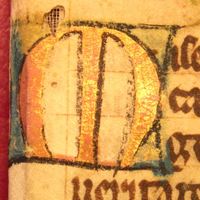






Uploads
Papers by Giedrius Subačius
Entire Lopacinskis’s epitaph was chiseled out in capital letters. Analysis shows, however, that most of the text written by Daukantas hand must have initially been rendered in lower case letters. And Daukantienė’s epitaph might have been chiseled out not directly from Daukantas’s handwritten note, but from the text first set in print.
Daukantas spelled his mother’s last name DAU‑KONTIENE with the digraph <on>, signifying her native dialectal diphthong [ọn]. Elsewhere at the time Daukantas preferred different digraph <ąn>, so the spelling with <on> might have been an important identity trait of his mother and of his entire family. Had Daukantas’s own signature in Lithuanian survived, it might have contained the same digraph <on> – Daukont’s or Daukontas.
It is obvious that Daukantas had the earlier translation in front of him while preparing the publication. But even if he copied some features of his old orthography, he also often changed the orthography according to his later altered preferences.
Another book by Daukantas published the same year (1846) was Pasakas Phedro (PaPhs), a translation of The Fables of Phaedrus. The manuscript of PaPhs was prepared in Daukantas’ own quite renewed orthography (compared to his older manuscript of the same fables Pasakas Paedraus from the first half of 1836).
The first quarter of the GDKs text was prepared in similar way to PaPhs: Daukantas preferred to replace old orthographic features with newer ones. However, the other three quarters of the GDKs book were prepared differently: many more older orthographic peculiarities were introduced, such as: <‑iba, ‑ibe> (not <‑yba, ‑ybe>); <‑ay, ‑ey>, <‑ai, ‑ei> (not <‑aj, ‑ej>); <‑ij, ‑ei> in open [‑ẹi] flexions (not <‑ĩj>); <ei>, <ęi>, <ij> in word roots (not <ĩj>); inf. suffix <‑itĩ> (not <‑ytĩ>). The most plausible reason for the decline in Daukantas’ interest in renewing the older orthography in his new manuscript (beginning in the second quarter) was his sudden illness. Daukantas claimed that at the beginning of January 1846, the blood was rushing inside his head so much that he thought he was going mad or dying, and only after four months did the doctors manage to help him recover enough so that he was able to walk. Nevertheless, the pain in his legs was still terrible, and he could not walk further than a few hundred paces at a time. And approximately at that time, Daukantas was working on his GDK manuscript, so it is possible that the misfortune befell him when he was a quarter of the way through his work. It also means that, even though sick and in pain, he continued writing.
Not all the orthographic features were of the same stability. Some of them were quite stable, and Daukantas adapted new versions of expressions even while he was ill (yra; <‑ajs, ‑ejs>; <ąn ąm>; <‑tĩ>; buwo). Other features were less stable and even very unstable, affected by the obvious influence of the orthography of the former manuscript. Among the least stable was the discarding of the grapheme <y> in the position of a long vowel [i·, i]: derivatives with the inf. suffix <‑it‑>; the root giw‑ (‘life, alive’), etc. Also, the diacritical grapheme <ù> was not stable either in PaPhr or in GDKs.
These old graphemes that penetrate new texts might be termed palimpsestic. Old graphemes in new texts, especially those that are characterised by less stability, are palimpsestic. This feature was present to some degree in other writings by Daukantas as well: in some manuscripts we can unexpectedly find the grapheme <y> with the very old meaning of the Lowland Lithuanian sound [ẹ] (pronounced somewhat between [i] and [e]), such as the History of the Lithuanian Lowlands of 1831–1834; proverbs copied from Kristijonas Gotlybas Milkus’ dictionaries and Lowland Lithuanian proverbs, both from about 1838, etc. Also, beside the newer grapheme <ó> [ọ], we can find the older <ù> [ọ] in Lowland Lithuanian proverbs, which is a sign that the text was copied from an older manuscript and acquired the former palimpsestic <ù>.
Daukantas borrowed the word valstybė from Latvian. He believed he had appropriated the word from the Herulian language (not Latvian) via Joachim Lelewel’s text. The word had reached Daukantas Lelewel (1808) → Daukantas (1831–1833).
Daukantas’ work at the General Governor’s office in Rīga must have stimulated him to transfer valstybė into Lithuanian. Daukantas must have seen the printed texts containing the Latvian combination Kreewu(=) walſtibas ‘of the Russian state’ that were circulating in the office, which could have encouraged him to adapt it for his Lithuanian text.
One of the first to resurrect Daukantas’ forgotten loanword valstybė was the writer, political activist Povilas Višinskis, in the January 29 [February 11], 1905 issue of the Lithuanian newspaper Vilniaus žinios (‘Vilnius News’) in the article “Kiek pinigų surenka ir išleidžia Rusų vyriausybė” (How Much Money the Russian Government Collects and Spends). Possibly, during the beginning and certainly by the middle of 1905 Višinskis fully switched to using the word valstybė and abandoned viešpatystė and valstija, which were popular synonyms at the time. After Višinskis, a member of the Lithuanian Social Democratic Party, Augustinas Janulaitis, used the word valstybė in March and April, 1905. At the very end of 1905 the linguist Jonas Jablonskis must have accepted the fact that valstybė had become the more widely used word.
The Russian revolution and the war with Japan in 1905, the Great Assembly of Vilnius at the end of 1905, and the State Parliament elections at the beginning of 1906 made the concept of ‘state, polity’ very frequent and relevant. In 1906, valstybė finally won the competition with its synonyms as the most correct way of expressing the concept. It was noteworthy that Višinskis (circa January 1905) and Janulaitis (circa April 1905) had selected this word, but the approval by Jablonskis (circa December 1905) could have been the most decisive factor for the subsequent wide spread of the word valstybė.
(physicality) of writing tools and surfaces. In the development of orthographies,
the perception of durability and ephemerality has been a significant factor
as well: in certain cases, hopes for permanence as opposed to temporality
encouraged orthographic differences in written (printed) texts. In ancient
Rome, for example, capital letters carved in stone were more durable than the
minuscules used on wax tablets. After the invention of movable type printing
in fifteenth-century Europe, manuscripts became more ephemeral than
printed texts. For instance, newspapers printed in Lithuania at the end of the
nineteenth century were considered more perishable than printed books.
The materiality of the printing milieu was one of the main reasons for the
symmetry of the majuscules and minuscules in orthographies based on Latin
script and for the absence of most of the abbreviations that are characteristic
of medieval manuscripts. Constrained by the space available within printers’
type cases, the number of typefaces would have been limited, which may
have impacted the development of certain orthographies and may have constrained
the abundance of diacritic marks. The direct materiality of a sheet of
paper also may have influenced the presence of hyphens and abbreviations,
and in certain cases, the choice of graphemes.
This chapter focuses on the materiality of orthography as approached from
the perspective of such research fields as paleography, codicology and orthography.
Materiality as a physical condition or reason for spelling transformations
and variation is considered as either restrictive or encouraging physical
reality for an applied orthography. The chapter then discusses the way the
imaginary durability or ephemerality of the composed text might influence
the orthographic approach (minuscules vs. majuscules, double parallel...
(more frequent approach), or (2) just to keep them (more seldom).
(1) Habitually, Daukantas modified the features of the earlier PaP manuscript: (a) <i, î> [ẹ] → <ĩ> (Ƶînau ‘I know’ → Źĩnau); (b) [i·, i] in stems <i> → <y> (būti ‘to be’ present 3‑person form [ira ‘it is’ → yra], suffixes ‑yba, ‑ybė [prekibà ‘to the trade’ → prekybaj, narsibieje ‘in valor’ → narsybie], inf. suffix <i> → <y> [mokite ‘to teach’ → môkytĩ]); (c) in stems and endings <ai, ei> (<ae>, <iey>) → <aj, ej> (Ƶaemaite ‘Lowlanders’ → Ƶámajtej; w eislę ‘a breed’ → wejslę); (d) [ẹi] in open endings <ij> → <ĩj> (kurij ‘which ones’ → kùrĩj); (e) [ẹi] in roots <ei> → <ie> (deina ‘a day’→ dieną) and <ei> → <ĩj> (lijpę ‘[he] ordered’ → lĩjpę); (f) instr. pl. m. endings <‑ays, ‑eys>, <‑às, ‑ès> → <‑ajs, ‑ejs> (łondeys ragays ‘[with] the
pointed horns’ → łąndejs ragajs; aukuràs ‘[with] the altars’ → aukùrajs); (g) <on, om, an> (<un>) [ọn, an, ọm, am] → <ąn, ąm> (spindontiomys ‘[with] the glittering [something]’ → spindąntiomis; gełombiemys ‘[with] the baize’ → gełąmbiemis); (h) inf. ending <‑te> → <‑tĩ> (důte ‘to give’ → důtĩ); (i) būti ‘to be’ past 3‑person form bů ‘was’ → buwo; (j) dat. sg. m. and adv. Lowlanders’ endings <‑ů> [ọu] → Highlanders’ endings <‑uj> [‑ui] (skaititoiů ‘to a reader’ → skajtitojuj, pasků ‘later; afterwards’ → paskuj).
(2) More occasionally he was influenced by the equivalent in the prototype PaP and kept it: (a) [i·, i] in stems <i> = <i> (in forms deriving from inf. suffix [pawiks ‘(I) will succeed’ = pawiks]), in the root gyv‑ (negiwije ‘dead ones’ ≈ negiwĩje), in other roots (ligino ‘[he] leveled’ = ligino; tiłù ‘silently’ = tiłù); (b) grapheme <ù> [ọ] (miniesinù ‘[with] the mentioning’ = miniesinù).
Daukantas abundantly exploited one feature in both old and new orthographic versions: graphemes <ů> / <ou> (ůdegą ‘a tail’ = ůdegą; pardůs ‘will sell’ → pardous). He essentially returned to his older grapheme <ů> (168×), although equally important remained the digraph <ou> (205×). In the initial (pp. 3–9) and final (pp. 52–63) segments of the PaPhr manuscript, Daukantas chose only the digraph <ou>, but within the inner (pp. 3–11, 26–51) segments his tactic was different: he blended <ů> with <ou>. Another tendency: frequent
pronominal acc. sg. forms ką, tą and instr. sg. kuo, tuo (including variations) were mostly rendered as kou, tou, most probably due to the old knack of his hand.
In certain cases, Daukantas modified not only orthography, but dialect forms as well, i.e. he chose different diatopic variants. Instead of the former Lowland forms, he switched to these Highland equivalents: (a) digraph <ie> [ie] in the roots dien‑ ‘day’, Diev‑ ‘God’, vien‑ ‘one’, viet‑ ‘place’; (b) dat. sg. m. and adv. endings <‑uj> [ui]; (c) past 3-person form buwo ‘was, were’.
The printer of the book (PaPhs) was Eduard Pratz in St Petersburg. His typesetters worked better than the typesetters at the printing press of Christian Hintze that Daukantas used for his earlier publications. In Hintze’s editions there were many mistakes in both letters and their diacritical marks. In PaPhs, however, there were fewer cases of grapheme confusion. It is highly probable that at least one of the PaPhs typesetters knew Lithuanian (especially the setter of the fourth and fifth signatures on pp. 37–48, 49–60), and that at least one was ignorant of it (the setter of the third signature, especially pp. 29–36).
It is thinkable that Daukantas could have familiarised himself with the typeset text before some of the proofs were corrected (the word Leaukys ‘wolf’, typical only of Daukantas, was introduced in print even though the manuscript lacks it). The majority of the corrections, however, were probably established by the typesetters, especially by the one who knew Lithuanian and introduced some forms atypical of Daukantas himself (such as tautosyllabic digraph <ĩn> [ẹn]—teatsitink ‘let it happen’ → teatsĩtĩnk). The financial supporter of the publication, Ksaveras Kanapackis, might have been a speaker of the Eastern Highland dialect; thus, he was not in a position to insert such Lowland dialect features as iness. sg. f. (pastogie ‘in the shelter’) and diacritical letters <ĩ> [ẹ] and <ù> [ọ].
Entire Lopacinskis’s epitaph was chiseled out in capital letters. Analysis shows, however, that most of the text written by Daukantas hand must have initially been rendered in lower case letters. And Daukantienė’s epitaph might have been chiseled out not directly from Daukantas’s handwritten note, but from the text first set in print.
Daukantas spelled his mother’s last name DAU‑KONTIENE with the digraph <on>, signifying her native dialectal diphthong [ọn]. Elsewhere at the time Daukantas preferred different digraph <ąn>, so the spelling with <on> might have been an important identity trait of his mother and of his entire family. Had Daukantas’s own signature in Lithuanian survived, it might have contained the same digraph <on> – Daukont’s or Daukontas.
It is obvious that Daukantas had the earlier translation in front of him while preparing the publication. But even if he copied some features of his old orthography, he also often changed the orthography according to his later altered preferences.
Another book by Daukantas published the same year (1846) was Pasakas Phedro (PaPhs), a translation of The Fables of Phaedrus. The manuscript of PaPhs was prepared in Daukantas’ own quite renewed orthography (compared to his older manuscript of the same fables Pasakas Paedraus from the first half of 1836).
The first quarter of the GDKs text was prepared in similar way to PaPhs: Daukantas preferred to replace old orthographic features with newer ones. However, the other three quarters of the GDKs book were prepared differently: many more older orthographic peculiarities were introduced, such as: <‑iba, ‑ibe> (not <‑yba, ‑ybe>); <‑ay, ‑ey>, <‑ai, ‑ei> (not <‑aj, ‑ej>); <‑ij, ‑ei> in open [‑ẹi] flexions (not <‑ĩj>); <ei>, <ęi>, <ij> in word roots (not <ĩj>); inf. suffix <‑itĩ> (not <‑ytĩ>). The most plausible reason for the decline in Daukantas’ interest in renewing the older orthography in his new manuscript (beginning in the second quarter) was his sudden illness. Daukantas claimed that at the beginning of January 1846, the blood was rushing inside his head so much that he thought he was going mad or dying, and only after four months did the doctors manage to help him recover enough so that he was able to walk. Nevertheless, the pain in his legs was still terrible, and he could not walk further than a few hundred paces at a time. And approximately at that time, Daukantas was working on his GDK manuscript, so it is possible that the misfortune befell him when he was a quarter of the way through his work. It also means that, even though sick and in pain, he continued writing.
Not all the orthographic features were of the same stability. Some of them were quite stable, and Daukantas adapted new versions of expressions even while he was ill (yra; <‑ajs, ‑ejs>; <ąn ąm>; <‑tĩ>; buwo). Other features were less stable and even very unstable, affected by the obvious influence of the orthography of the former manuscript. Among the least stable was the discarding of the grapheme <y> in the position of a long vowel [i·, i]: derivatives with the inf. suffix <‑it‑>; the root giw‑ (‘life, alive’), etc. Also, the diacritical grapheme <ù> was not stable either in PaPhr or in GDKs.
These old graphemes that penetrate new texts might be termed palimpsestic. Old graphemes in new texts, especially those that are characterised by less stability, are palimpsestic. This feature was present to some degree in other writings by Daukantas as well: in some manuscripts we can unexpectedly find the grapheme <y> with the very old meaning of the Lowland Lithuanian sound [ẹ] (pronounced somewhat between [i] and [e]), such as the History of the Lithuanian Lowlands of 1831–1834; proverbs copied from Kristijonas Gotlybas Milkus’ dictionaries and Lowland Lithuanian proverbs, both from about 1838, etc. Also, beside the newer grapheme <ó> [ọ], we can find the older <ù> [ọ] in Lowland Lithuanian proverbs, which is a sign that the text was copied from an older manuscript and acquired the former palimpsestic <ù>.
Daukantas borrowed the word valstybė from Latvian. He believed he had appropriated the word from the Herulian language (not Latvian) via Joachim Lelewel’s text. The word had reached Daukantas Lelewel (1808) → Daukantas (1831–1833).
Daukantas’ work at the General Governor’s office in Rīga must have stimulated him to transfer valstybė into Lithuanian. Daukantas must have seen the printed texts containing the Latvian combination Kreewu(=) walſtibas ‘of the Russian state’ that were circulating in the office, which could have encouraged him to adapt it for his Lithuanian text.
One of the first to resurrect Daukantas’ forgotten loanword valstybė was the writer, political activist Povilas Višinskis, in the January 29 [February 11], 1905 issue of the Lithuanian newspaper Vilniaus žinios (‘Vilnius News’) in the article “Kiek pinigų surenka ir išleidžia Rusų vyriausybė” (How Much Money the Russian Government Collects and Spends). Possibly, during the beginning and certainly by the middle of 1905 Višinskis fully switched to using the word valstybė and abandoned viešpatystė and valstija, which were popular synonyms at the time. After Višinskis, a member of the Lithuanian Social Democratic Party, Augustinas Janulaitis, used the word valstybė in March and April, 1905. At the very end of 1905 the linguist Jonas Jablonskis must have accepted the fact that valstybė had become the more widely used word.
The Russian revolution and the war with Japan in 1905, the Great Assembly of Vilnius at the end of 1905, and the State Parliament elections at the beginning of 1906 made the concept of ‘state, polity’ very frequent and relevant. In 1906, valstybė finally won the competition with its synonyms as the most correct way of expressing the concept. It was noteworthy that Višinskis (circa January 1905) and Janulaitis (circa April 1905) had selected this word, but the approval by Jablonskis (circa December 1905) could have been the most decisive factor for the subsequent wide spread of the word valstybė.
(physicality) of writing tools and surfaces. In the development of orthographies,
the perception of durability and ephemerality has been a significant factor
as well: in certain cases, hopes for permanence as opposed to temporality
encouraged orthographic differences in written (printed) texts. In ancient
Rome, for example, capital letters carved in stone were more durable than the
minuscules used on wax tablets. After the invention of movable type printing
in fifteenth-century Europe, manuscripts became more ephemeral than
printed texts. For instance, newspapers printed in Lithuania at the end of the
nineteenth century were considered more perishable than printed books.
The materiality of the printing milieu was one of the main reasons for the
symmetry of the majuscules and minuscules in orthographies based on Latin
script and for the absence of most of the abbreviations that are characteristic
of medieval manuscripts. Constrained by the space available within printers’
type cases, the number of typefaces would have been limited, which may
have impacted the development of certain orthographies and may have constrained
the abundance of diacritic marks. The direct materiality of a sheet of
paper also may have influenced the presence of hyphens and abbreviations,
and in certain cases, the choice of graphemes.
This chapter focuses on the materiality of orthography as approached from
the perspective of such research fields as paleography, codicology and orthography.
Materiality as a physical condition or reason for spelling transformations
and variation is considered as either restrictive or encouraging physical
reality for an applied orthography. The chapter then discusses the way the
imaginary durability or ephemerality of the composed text might influence
the orthographic approach (minuscules vs. majuscules, double parallel...
(more frequent approach), or (2) just to keep them (more seldom).
(1) Habitually, Daukantas modified the features of the earlier PaP manuscript: (a) <i, î> [ẹ] → <ĩ> (Ƶînau ‘I know’ → Źĩnau); (b) [i·, i] in stems <i> → <y> (būti ‘to be’ present 3‑person form [ira ‘it is’ → yra], suffixes ‑yba, ‑ybė [prekibà ‘to the trade’ → prekybaj, narsibieje ‘in valor’ → narsybie], inf. suffix <i> → <y> [mokite ‘to teach’ → môkytĩ]); (c) in stems and endings <ai, ei> (<ae>, <iey>) → <aj, ej> (Ƶaemaite ‘Lowlanders’ → Ƶámajtej; w eislę ‘a breed’ → wejslę); (d) [ẹi] in open endings <ij> → <ĩj> (kurij ‘which ones’ → kùrĩj); (e) [ẹi] in roots <ei> → <ie> (deina ‘a day’→ dieną) and <ei> → <ĩj> (lijpę ‘[he] ordered’ → lĩjpę); (f) instr. pl. m. endings <‑ays, ‑eys>, <‑às, ‑ès> → <‑ajs, ‑ejs> (łondeys ragays ‘[with] the
pointed horns’ → łąndejs ragajs; aukuràs ‘[with] the altars’ → aukùrajs); (g) <on, om, an> (<un>) [ọn, an, ọm, am] → <ąn, ąm> (spindontiomys ‘[with] the glittering [something]’ → spindąntiomis; gełombiemys ‘[with] the baize’ → gełąmbiemis); (h) inf. ending <‑te> → <‑tĩ> (důte ‘to give’ → důtĩ); (i) būti ‘to be’ past 3‑person form bů ‘was’ → buwo; (j) dat. sg. m. and adv. Lowlanders’ endings <‑ů> [ọu] → Highlanders’ endings <‑uj> [‑ui] (skaititoiů ‘to a reader’ → skajtitojuj, pasků ‘later; afterwards’ → paskuj).
(2) More occasionally he was influenced by the equivalent in the prototype PaP and kept it: (a) [i·, i] in stems <i> = <i> (in forms deriving from inf. suffix [pawiks ‘(I) will succeed’ = pawiks]), in the root gyv‑ (negiwije ‘dead ones’ ≈ negiwĩje), in other roots (ligino ‘[he] leveled’ = ligino; tiłù ‘silently’ = tiłù); (b) grapheme <ù> [ọ] (miniesinù ‘[with] the mentioning’ = miniesinù).
Daukantas abundantly exploited one feature in both old and new orthographic versions: graphemes <ů> / <ou> (ůdegą ‘a tail’ = ůdegą; pardůs ‘will sell’ → pardous). He essentially returned to his older grapheme <ů> (168×), although equally important remained the digraph <ou> (205×). In the initial (pp. 3–9) and final (pp. 52–63) segments of the PaPhr manuscript, Daukantas chose only the digraph <ou>, but within the inner (pp. 3–11, 26–51) segments his tactic was different: he blended <ů> with <ou>. Another tendency: frequent
pronominal acc. sg. forms ką, tą and instr. sg. kuo, tuo (including variations) were mostly rendered as kou, tou, most probably due to the old knack of his hand.
In certain cases, Daukantas modified not only orthography, but dialect forms as well, i.e. he chose different diatopic variants. Instead of the former Lowland forms, he switched to these Highland equivalents: (a) digraph <ie> [ie] in the roots dien‑ ‘day’, Diev‑ ‘God’, vien‑ ‘one’, viet‑ ‘place’; (b) dat. sg. m. and adv. endings <‑uj> [ui]; (c) past 3-person form buwo ‘was, were’.
The printer of the book (PaPhs) was Eduard Pratz in St Petersburg. His typesetters worked better than the typesetters at the printing press of Christian Hintze that Daukantas used for his earlier publications. In Hintze’s editions there were many mistakes in both letters and their diacritical marks. In PaPhs, however, there were fewer cases of grapheme confusion. It is highly probable that at least one of the PaPhs typesetters knew Lithuanian (especially the setter of the fourth and fifth signatures on pp. 37–48, 49–60), and that at least one was ignorant of it (the setter of the third signature, especially pp. 29–36).
It is thinkable that Daukantas could have familiarised himself with the typeset text before some of the proofs were corrected (the word Leaukys ‘wolf’, typical only of Daukantas, was introduced in print even though the manuscript lacks it). The majority of the corrections, however, were probably established by the typesetters, especially by the one who knew Lithuanian and introduced some forms atypical of Daukantas himself (such as tautosyllabic digraph <ĩn> [ẹn]—teatsitink ‘let it happen’ → teatsĩtĩnk). The financial supporter of the publication, Ksaveras Kanapackis, might have been a speaker of the Eastern Highland dialect; thus, he was not in a position to insert such Lowland dialect features as iness. sg. f. (pastogie ‘in the shelter’) and diacritical letters <ĩ> [ẹ] and <ù> [ọ].
The book The Experts of Lithuanian in Service of the Russian Empire: Dmitrii Kashirin, Zakharii Lyatskii, and Andrius Poidėnas (Vilnius: Institute of the Lithuanian Language, 2011) recounts linguistic biographies of the three experts who served the administration of the Vilnius Education District to prepare, edit, evaluate, review, and correct certain Lithuanian texts in Cyrillic. Most of the Lithuanian Cyrillic texts approved by the imperial administrators in the Vilnius Education District were distributed to the schools and the populace in the form of primers and public readings. In the rare cases of private initiatives to print Lithuanian books in Cyrillic alphabet (e.g., that of Juozapas Miliauskas), the experts were used by the administrators to criticize and to reject the unwelcome proposals.
By and large this book deals with the life and work of Kashirin, Lyatskii, and Poidėnas: the three experts producing and evaluating Lithuanian Cyrillic during the 1867–1901 period of the ban on Latin script. It does not cover, however, the initial period of Lithuanian Cyrillization from 1864 to 1867, which is associated with the names of other experts: Stanisław Mikucki, Laurynas Ivinskis, Jonas Krečinskis, and Tomas Žilinskis.
.................
http://www.uic.edu/classes/lith/lith520/SUB_kn/SUB_2011_SUMMARY_of_BOOK_Experts_of_Lithuanian_in_Service_of_Russian_Empire.pdf
This is the very first known Lithuanian grammar based on the Lowland Lithuanian dialect (ca. 1820–1830).
1. Peculiarities of the X.D.K.P.S. manuscript grammar
The manuscript of the X.D.K.P.S. grammar is a final clean copy. The text of the grammar covers pp. 1–78 of the manuscript and pp. 87–100 are used for an additional list of Lithuanian-Polish words. The paper of the manuscript is blue and it carries five different water marks. The water marks on some sheets of the manuscript paper show the years 1819 and 1820; that is, the dates of the paper’s manufacture. The manuscript had been kept at the Puławy Library of Czartoryscy, most probably up to the 1830 Polish insurrection against Russia. Therefore, the X.D.K.P.S. grammar most likely was written around 1820 but certainly before 1830. The binding is made of red paper over cardboard. Remnants of two cover ties still remain.
2. History of the X.D.K.P.S. manuscript
There are many new traces discovered in the history of the X.D.K.P.S. manuscript. Briefly it can be described in the following way: the grammar was composed ca. 1820–1830, kept in the Czartoryscy Library in Puławy, Poland (up to 1830), then it was evacuated to the Czartoryscy’s estate in Sieniawa (ca. 1832–1849), then taken to Paris (1849–1872?), then returned to Poland again, to the Kórnik Library (ca. 1872–1874?). Finally it was brought to Cracow (ca. 1874?) and remains there up to the present. The manuscript of the X.D.K.P.S. grammar suffered all these “peregrinations” because of the attempts by the Czartoryscy family to protect their library from the Russian government’s efforts to confiscate it.
The first known written mention of the manuscript occurred in 1834 in Sieniawa. In 1859, in Paris, the item gets its first “call number”: number 6 in red pencil and the inscription in black ink “Str: 117 Katalogu” (which meant the page number of the catalog compiled for the Czartoryscy Library in the Paris period). The last call number (2281) remains unchanged today and was assigned to the X.D.K.P.S. manuscript also in the Paris period, most probably ca. 1869 by Wł. Skrzydyłka.
3. The author of the X.D.K.P.S. grammar
A possible version is that the author of the grammar signed “X.D.K.P.S.” was a priest of noble origin. He could have also been a teacher at some parish school. He was not a resolute man. His grammar was intended for beginners: the book offers only very basic grammar. There is no evidence of a conscious resolution to create his own model of the standard language; he evinces only the nascent need for a standard language.
It is worthwhile to note that the cryptonym “X.D.K.P.S.” was used only once, namely, it is stamped in silver on the front cover. We don’t know when the manuscript was bound, but it appears reasonable to assume that the binder must have known the real name of the author. None of the librarians of Czartoryscy Library throughout different periods ever mentioned a name. It is also reasonable, then, to assume, that the manuscript was bound before it reached the Library. The unknown author himself could have been involved in the process of binding.
The author used long shaped letters <ſ>, <ʒ> in his long hand inconsistently. He also used the digraph <aw>. These particularities of orthography were almost standard for eighteenth-century Lithuanian texts. This makes it very probable that the anonymous X.D.K.P.S. was educated before the end of the eighteenth century.
4. The structure and context of the grammar
The X.D.K.P.S. grammar is composed of three parts. The first one contains the rules of pronunciation of Lithuanian letters, syllables, and words, also the rules of orthography and the parts of speech. The second part is devoted to the declined parts of speech (nouns, adjectives, pronouns, some participles) and their paradigms and usage. It also includes a description of adverbs. The third part encompasses verbs first of all. But at the end of it there are descriptions of adverbs, syntax, conjunctions, and interjections. Thus, the X.D.K.P.S. grammar covers all the major grammatical topics, even though it is only an introductory attempt at a grammar in Lithuania Major at that time.
5. The peculiarities of the language. The intention to select a dialect
Linguists used to think that the author of the X.D.K.P.S. grammar was attempting to combine Highland and Lowland dialectal forms. In the text of the grammar, however, Lowland dialectal forms predominate (in the order of degree of noticeability: Katrus ‘which’, Dyrbtio ‘I would work’, biegu ‘I run’, reyk ‘it needs’, gerewsyms ‘for the best’, Broluse ‘in brothers’, bukiem ‘let’s be’, turietyny ‘the ones that have to be kept’, Szey ‘these’, owłas ‘rocks’, Tiewow ‘for father’). Only one feature—monophthongs [ā] and [ē] in word final position—were consistently expressed in Highland forms (bałtays ‘[with] white ones’). Two of these features were replaced inconsistently by Highland forms, that is, Lowl. [ẹi] and [ọu]: Wienas ‘one’, dodąs ‘giving’ (only two words with [ọu] were replaced with Highland forms: duoti and duona).
It is evident that the author used primarily his native Lowland dialect, but he did not codify his language to a sufficient degree (we cannot discern any strict concept of codification), neither did he achieve an adequate level of accuracy. Forms with [ẹi] instead of West Highl. ę (Kętas ‘hard’ cf. with analogous <ę> used in atsygręźk ‘turn around’) and with [ọu] instead of West Highl. ą (Owźowłas ‘an oak’) testify to the fact that the author came from the north-west Dounininkai-Lowland area.
6. Orthography
The analysis of dialectal forms and orthography does not reveal any convincing signs of influence of traditional Dounininkai-Lowland texts, Ziwatas (1759) and Kozonius (1794), or Jurgis Ambraziejus Pabrėža’s (1771–1849) manuscripts. This also indicates that the author was rather independent in selecting dialectal norms and graphemes for orthography.
7. The purpose of the grammar and the conception of standard language
The grammar is neither large nor comprehensive. It was intended for beginners and for publication. This allows us to presume that the author wanted to prepare a manual; perhaps he was concerned about the teaching of the native language in schools. On the other hand, it is evident that the author felt the need for a future Lithuanian standard: this enables us to speak at least about his initial desire to have a standard language.
8. The parameters of intended standard language
Although he chose the Dounininkai-Lowland dialect, the author might also include as territory for the standard language the territory coinciding with the Lithuanian ethnic areas of Lithuania Major, rather than the Lithuanian Lowland alone; even the term the Lowland language is absent from his texts and the term the Lithuanian language is used. It seems that an overly syncretic attitude toward orthography and pronunciation hindered the grammarian from differentiating a spoken standard language from the written one: he still recognized only one syncretic variety of the future standard language. In this regard his model differed from those of bishop Juozas Arnulfas Giedraitis (1757–1838) and Dionizas Poška (1765–1830), who understood and emphasized the difference between the written and the spoken languages at that time. The author’s priorities also depended on rules. By his erroneous rules he modified entire word paradigms, for example, he considered akmow ‘a stone’, Nosys ‘a nose’ as erroneous forms and Akmenis, Nose as their correct equivalents. Even though he gives a priority to rules, he can be said to have syncretically sensed the importance of the spoken language. "